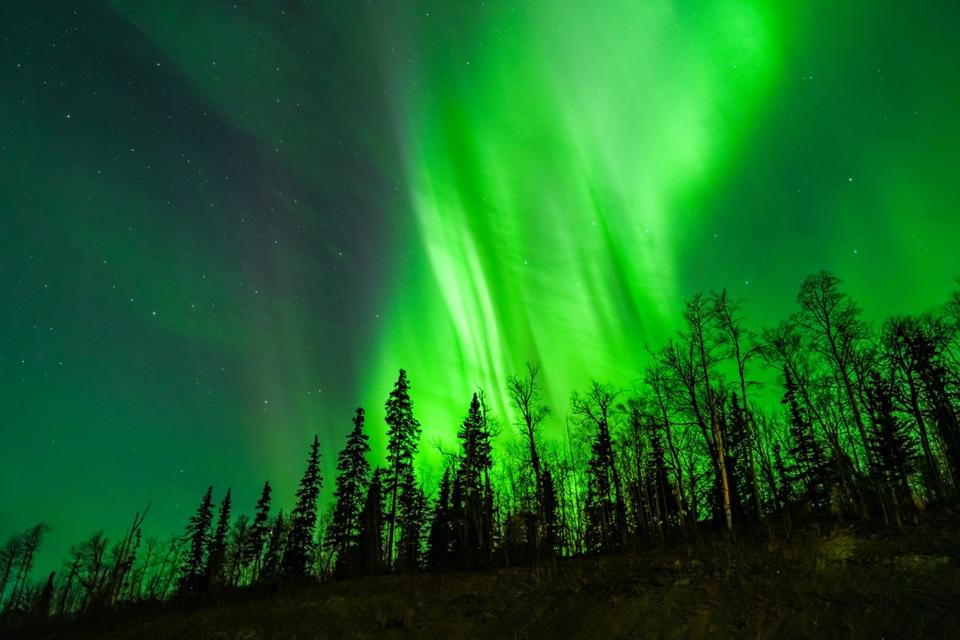The Northern Lights may be visible on camera — and possibly to the naked eye — across 12 northern U.S. states and Canada as soon as it gets dark on Tuesday, Oct. 28, according to a forecast from the National Oceanic and Atmospheric Administration’s Space Weather Prediction Center (SWPC). The forecast includes a geomagnetic storm that could see displays of aurora.
The forecast comes as a coronal mass ejection — a cloud of super-charged particles that leaves the sun and takes a few days to reach Earth — is expected to hit Earth’s magnetic field, followed by fast-moving solar wind.
Northern Lights Forecast: What To Expect
NOAA forecasters believe the combined impact will likely be a G1 or G2-rated geomagnetic storm — and auroras in northern U.S. states, Canada and northern Europe.
“G1 (Minor) conditions, with a chance for G2 (Moderate)
levels, are likely on 28-29 Oct due to the anticipated onset of
influence from a positive polarity coronal hole,” reads the forecast. A positive polarity coronal hole is a when magnetic field lines point away from the sun, so escape into space, sometimes in the direction of Earth.
Northern Lights Forecast: Where And When
NOAA’s latest aurora viewlines indicate that aurora displays are a possibility in northern U.S. states and Canada, with 12 U.S. states having a chance after dark on Tuesday, Oct. 28. Intensity levels could reach Kp 5 — an active level of space weather — as soon as it gets dark in North America, and remain all night.
U.S. states that may see aurora include Alaska and (northerly parts of) Washington, Idaho, Montana, Wyoming, North Dakota, South Dakota, Minnesota, Wisconsin, Michigan, New York and Maine.
Dark northern skies away from urban light pollution are likely to offer the best views. Useful ways to locate a dark place are the Dark Sky Place Finder and a light pollution map.
What Causes The Northern Lights
The solar wind causes the Northern Lights — streams of charged particles flowing from the sun and interacting with Earth’s magnetic field. While most are deflected, some particles spiral along magnetic field lines toward the poles, colliding with oxygen and nitrogen atoms high in the atmosphere. These collisions excite the gases, causing them to release energy as shimmering light.
Northern Lights Forecast: Latest Updates
All forecasts for the aurora must be treated with caution. To check visibility in real time, use NOAA’s 30-minute aurora forecast, or download apps such as Aurora Now, My Aurora Forecast or Glendale Aurora for up-to-the-minute alerts and live solar wind data.
Aurora-chasers frequently use the Kp index to predict the intensity of a geomagnetic storm, but for aurora displays, the interplanetary magnetic field’s Bz component is more important (you’ll find it in some of the above apps and on SpaceWeatherLive.com).
Bz determines how easily solar energy enters Earth’s magnetosphere. When Bz points north, Earth’s field resists it; when Bz swings south, the two fields connect, allowing plasma to stream in. A sustained southward Bz of −5 nT or stronger usually signals an imminent display of aurora.
Northern Lights: Why To Travel For The Best Displays
To almost guarantee seeing the Northern Lights at any part of the solar cycle, aim for the auroral oval, which spans latitudes between 60 and 75 degrees. The oval sits over Alaska, northern Canada, northern Norway, Sweden, Finland and Iceland. In these latitudes, auroras are visible several nights per week from September through March. Stay for at least three nights to improve your chances of clear skies, checking local forecasts before venturing out.
Wishing you clear skies and wide eyes.

